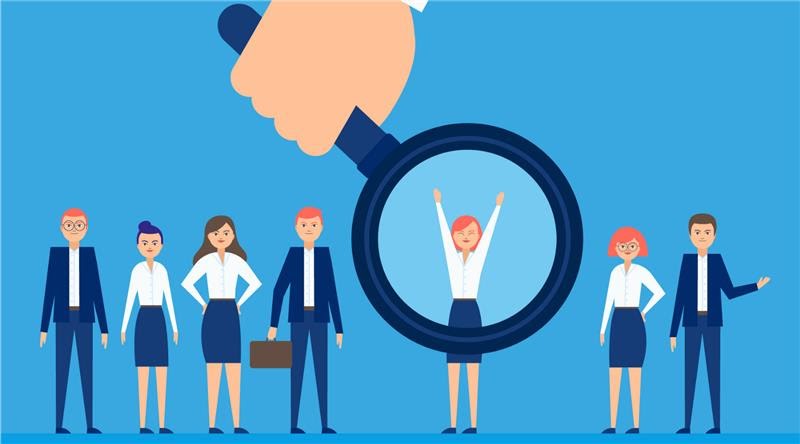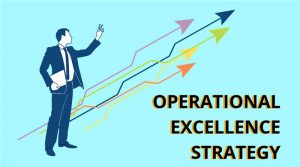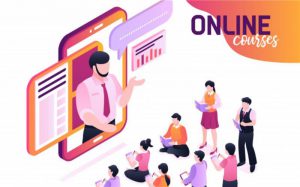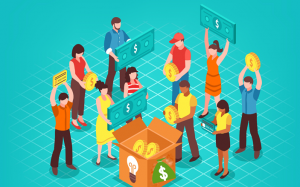Before creating a product you should be well versed with your customer. Moreover, it’s not just a problem rather you should also be well versed on how to propose a solution.
However, the biggest challenge that you face throughout the journey is creating a value proposition not only for your customers but also for investors.
As an Entrepreneur, you must be having a lot of questions in your mind.
Is it what customers want?
Are we wasting our time and money?
Are we sure that we are building the correct product?
Well! Steven G. Blank came to the rescue with its Customer Development Model as described in his book, The Four Steps to the Epiphany. The book stresses on a way to build up an organization while it’s still within the early stages.
He describes a set of milestones and objectives that are meaningful for a startup.
And the first step is called “customer discovery,” where the objective is to identify your customers and Discover the Pains and problems; and thereafter Finding solutions that match with the Identified Problem.
In this article, you will understand the customer discovery process through the Customer development model.
This will also help you to gain insight into four Phases of customer discovery and some ins and outs related to the Customer Discovery Process.
According to Steve Blank, “teams that build continuous customer discovery into their DNA become increasingly smart and adaptive to the ever-changing reality of the market.”
Customer Development Model
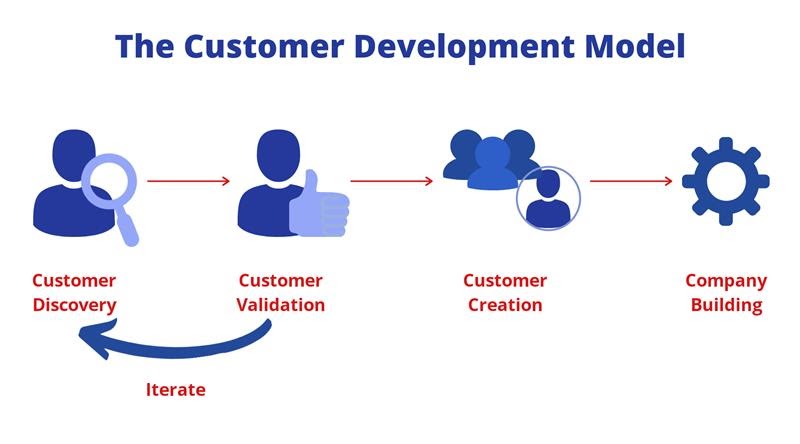
For each hour of customer development, businesses tend to save 5 to 10 to 20 hours of wasted development time. — Cindy Alvarez
While writing about his experiences of the ’90s in Silicon Valley, Blank noticed a pattern appearing from the startups in which he was involved.
He recognized that a startup is not merely a small version of a bigger company; in fact, they have unique challenges.
Startups have business models that require critical data, and these questions must be asked:
- Who are our ideal customers?
- What needs do they have?
- What are the features that they want?
- Which channels can be used to reach them?
- How do we maintain customer growth?
To overcome these problems and difficulties, Steve Blank subscribed to a “scalable and repeatable business model”. To create such an approach, he stressed that an entrepreneur gets out and tests the product in the real world.
The customer development model is a formal method for building new corporate ventures and startups. In addition to that, it is one of the three parts that make up a lean startup – business model design, customer development, and agile engineering.
Well, there are four phases in Steven G. Blank’s Customer Development Model. These stages constitute customer discovery, customer validation, customer creation, and company building.
Let’s dive into more details about these phases.
Customer Discovery
Customer Discovery is the first stage of The Customer Development Process pioneered by Steve Blank in the ’90s.
He started it after noticing countless startups fail as a result of not understanding how customers think.
It’s a focused process that helps you analyze your assumptions about your business. It involves taking direct feedback from customers.
There are 3 crucial points to Customer Discovery:
- When you meet potential customers, you develop a far better understanding of your audience and build your client base at a similar time.
- Customer Discovery is more about “breaking your assumptions” instead of confirming them. It is very easy to fall under the Confirmation Bias trap where we tend to look for information that confirms our beliefs.
- It is not just selling your solution or product to the customer. It’s about uncovering the information that would allow you to design a suitable solution.
Customer Validation
After the fundamental questions have been answered and hypotheses have been formed, it’s time to examine the scalability and repeatability of the hypotheses.
It creates a technique to check and validate those hypotheses with real/potential customers.
The first two steps of the customer development process are mainly about knowing about your customer.
Once you’ve validated your ideas about your customers, you’re ready to bring in more customers and build Business with the next steps.
Customer Creation
The main goal is to create demand and awareness for the solution by activating sales channels. In addition to that businesses can start spending on marketing as well at this step.
It is important to calculate before you start spending money. It prevents you from spending money and wasting time to position business in the wrong market.
Company Building
This is the final step of the customer Development process that transforms the “startup” into an execution-focused company.
In this, the business includes formal departments to escalate towards business development. This helps the management keep pace as the company grows.
Four Phases Of Customer Discovery
After a detailed overview of the customer development model that has four phases as customer discovery, customer validation, customer creation, and company building, we will discuss more on one of its four phases that is the customer discovery process.
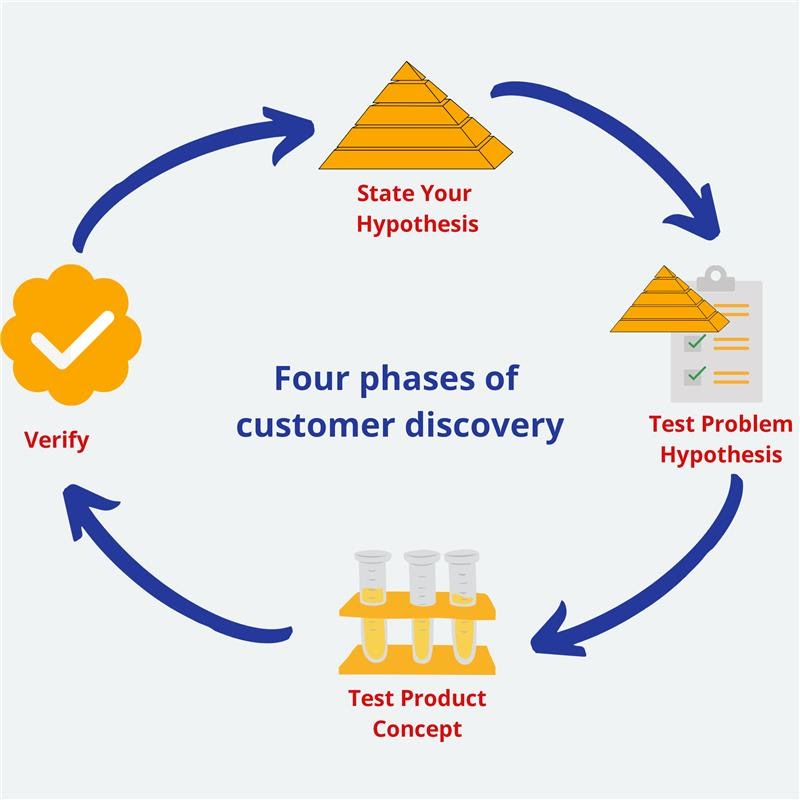
The four phases of the customer discovery process involve:
Phase 1: State Your Hypothesis
Before you begin conversations with prospective customers, you must have an idea of the problem that you believe exists or not. So, the first step is to form a hypothesis that defines both the problem and the solution you are proposing.
A simple way to frame this can be to fill within the following sentence: My idea solves [insert problem] by [insert solution].
For example: rather than saying, “My idea solves people’s ought to do laundry by offering a laundry delivery service,” a far better idea hypothesis could be-
“My idea solves the large time commitment and the inconvenience of maintaining clean laundry. This is done by providing a 24-hour delivery of laundry service.”
Once you have outlined the problem with the solution then you’re ready to analyze your hypothesis.
You must write down your most important business assumptions on the following in your business plan:
- Product concept
- Customers and the problems they want to solve
- Distribution and pricing
- Demand creation
- Market type
- Competition
The hypothesis is a summary of the things that you believe in based on the market.
Predictions
You should formalize predictions in your business plan. These predictions must be in writing.
- This practicality also offers psychological benefits. It is easier to avoid readjusting your hypotheses as you’re employed. When you do this, it is harder to keep up with changes. Not writing them down can even result in unsuccessful testing.
- Being able to pivot and alter during Customer Discovery and further steps of the Customer Development Model is crucial. But these alterations should be in controlled settings based on real information.
- Making changes on the fly is usually the result of inferences. Inferences are just different predictions. You need to wait until you’ve got the complete story before you begin making changes. This prevents confusion and offers more reliable results.
A good way to explain the types of those assumptions is to create a hypothetical customer persona. It’s just a profile of whom you think is the ideal customer for your business.
Be specific–give this person a name, a career, an age, hobbies, perspectives, interests, and even quotes regarding your industry. This is one of my favorite examples of customer persona below.
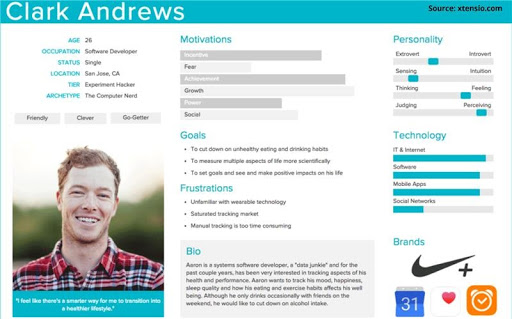
Great, so let’s take a look at five fantastic tools for creating your client personas.
Xtensio –
This is a free, robust tool that allows users to create a variety of shareable documents and presentations.
It includes a toolbox for strategy, marketing, operations, and business development. Sign up for access to Xtensio’s powerful features, free, and then hone in on the user persona template.
Hubspot–
Hubspot’s persona generator is a step-by-step wizard that will walk you through the process of creating a useful client, customer, or user persona for your business.
Up Close and Persona–
It’s very detailed compared to other persona generators. It will not only help you target your clients more effectively, but it can also help you position your business within your industry.
Smaply –
Smaply gives you the tools to visualize customer experience by creating personas, stakeholder maps, and journey maps.
Phase 2: Test Your Hypothesis
Once you have developed your market and product hypotheses, you can start analyzing them with potential customers.
The process of testing your hypothesis involves four steps as:

Tap Your Network
Begin by tapping your network: former colleagues, friends, investors, accountants, and lawyers. Build an inventory of potential customers on whom you’ll test your hypothesis.
Steven Blank suggests the list should consist of fifty names. At this time, don’t be too concerned about the position and rank your contacts as you’re not selling to them: you’re learning and gathering information.
Prepare Your Problem Presentation
Develop a presentation supporting hypothesis about customers and their problems as created in phase 1. Always keep in mind that the purpose of the presentation is not to sell.
The point is to seek feedback from your contacts based on their problems in terms of cost, efficiency loss, or performance loss.
In your presentation, include a high-level description of your product idea and invite feedback on it further.
Customer Insights
While talking to your contacts, use the chance to amass in-depth knowledge about their businesses by asking them questions beyond their problems.
Focus your questions on understanding the context of present operations.
For example, ask about how a particular day is spent, how related processes are performed, what are the main expense categories, or who the likely buyers or users would be of your solution.
Map The Market Infrastructure
Engage with industry analysts and also the media and attend conferences and trade shows to achieve a far better understanding of the environment.
Consider who your competitors might be, who has influence and power in this space, which companies are likely to buy, and what the trends are that occupy peoples’ minds in this market.
By the end of this phase, you’ll have an updated “problem statement.”
Phase 3: Test your product concept
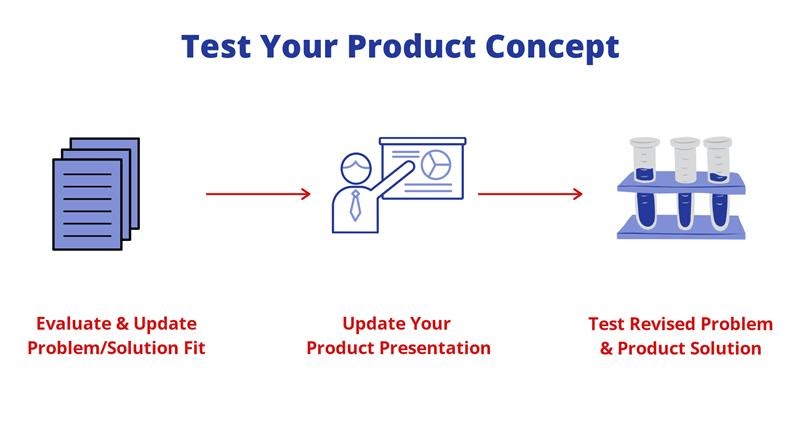
Once you understand the product, testing and qualifying your product concept are carried out involving the customer’s problem, their business, and therefore space within which they operate.
Evaluate Problem/Solution Fit
This phase of the customer discovery process involves taking the feedback and sharing it with your development team.
You can achieve this by asking questions.
For instance, if you’re running a college laundry business, you should not be asking your parents or professors questions.
They are not going to be your customers. Ask the people that you think will buy your product in the future. They hold the answers.
Example questions might include:
Tell me how you currently do _____________________.
How is that process working for you?
If you may do anything to boost your experience politely, what wouldn’t it be?
What’s the hardest part about ______________?
What do you like/dislike about ______________?
Together, you’ll need to consider the implications for your customer, your problem statement, your product hypothesis, and your product specifications.
Update Product Presentation
If your product is partially appropriate for the customers’ problems, then the solution could be to reconsider certain product features.
Once you’ve made this decision, you’ll need to create a brand new product presentation that reflects your changes.
The new presentation will enable you to ask your customers to review and validate the customer problem you’re solving and to check your new product specifications.
Test-Revised Problem and Product Solution
Any feedback you receive following this presentation must again be shared along with your development team.
Again test the revised problems that you encounter. This way, you ensure that you update your product development plans, and that customer and product development are conducted with the same goals in mind.
Phase 4: Evaluate customer feedback following the next steps
This step is the final phase of the customer discovery process; its purpose is to weigh the data you obtained earlier (in phase 2 and phase 3) from potential customers regarding your target market and product solution.
Consider if you are ready, to begin with, your current plans. If you’re not, the options are either to conduct another iteration of problem and solution validation that is, phases 2 and 3 or to pause your plans.
Before you choose whether or not to move ahead, you need to answer the subsequent critical questions:
- Has the customer problem been verified?
- Has the product solution been verified?
- Also, has the business model been verified?
Having answered these three key questions, you’ll be able to decide whether to advance to the customer validation stage of the customer development process or whether you need to recommence the customer discovery process or halt your project.
Frequently Asked Questions on Customer Discovery Process
Ever thought that how will you know that you are done with the customer discovery process? Let’s go through some infrequently asked questions on it.
What is the goal of customer discovery?
The goal of customer discovery is to estimate who are your customers and if your idea will appeal to them or not.
Remember, you are not trying to evaluate what every customer needs or wants. You are looking for your very first customer, not looking for the masses.
How Many Customers Should We Interview?
So, if our initial customer persona is “independent store owners,” but we have interviewed three or four retailers, then we will get a limited view.
On the other hand, if we are interviewing 50 people a week, we are going to get lost in the data.
We are not Google.
We don’t have the resources to start on an experiment to ascertain which of these 41 shades of blue will earn us an extra $300 million. Time is precious, so let’s concentrate on quality rather than quantity.
“The best indicator that you are done is that you stop hearing people say things that surprise you”
How Long Should My Interview Sprints be?
The aim is not to ask 50 questions and badger the person generously enough to share their time with you.
Also, you should not focus on spending a lot of overtime on interviews.
This presentation from Carnegie Mellon University suggests a quarter-hour interview time is sufficient.
And finally, interview quality matters and not quantity.
How Many Rounds of Interviews Should We Do?
Again: too few or too many?
This Nielsen study suggests 5 are enough to collect relevant data but this is often not set in stone.
As Steve Blank tells us, we want a lot of data, but only so we can extract insights from our customer discovery activities.
If you march “in person” to the customer channels you listed, you’ll have 10+ interviews and amazing data about your customers in your hands within 2/3 days betting on your niche.
How Do We Process The Information?
What are we searching for in our data? What will allow us to move from one round to subsequent, and ultimately to a product launch?
If we cross-check our interviews to tighten our customer persona and update our assumptions, then we are on our way.
Look for a customer segment that our product can effectively target and build a business model on.
So, if only 3 out of 20 store owners are interested in our product, that’s ok.
When Does the Customer Discovery Process End?
The industry is constantly changing. The market is constantly changing. People are constantly changing. Some of the simplest companies out there do discovery interviews weekly.
It’s a circuit course that helps us exercise and grow a viable business model.
So if we wish to be disruptors, we’d like to possess conversations with our customers and get comfortable talking to strangers.
Customer Discovery Process Template
Let’s go through a customer discovery process template. This is best used over phone or video call. Not meant for the face-to-face process.

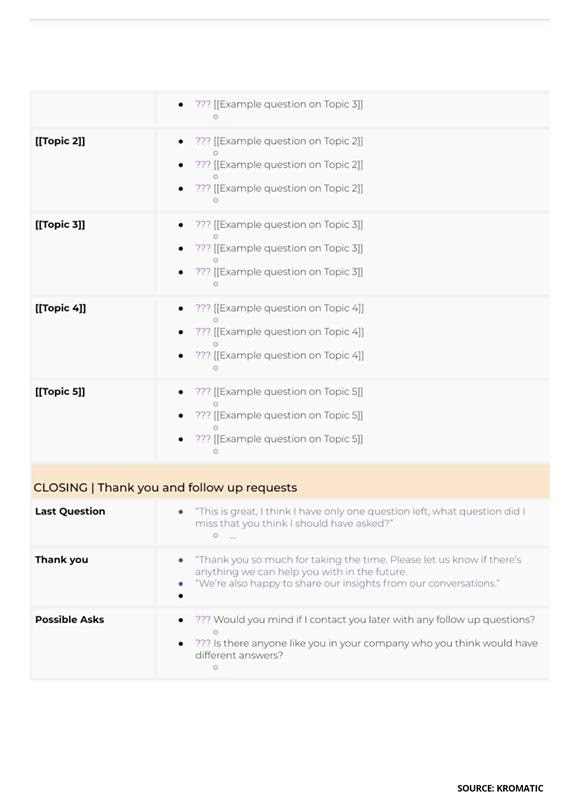
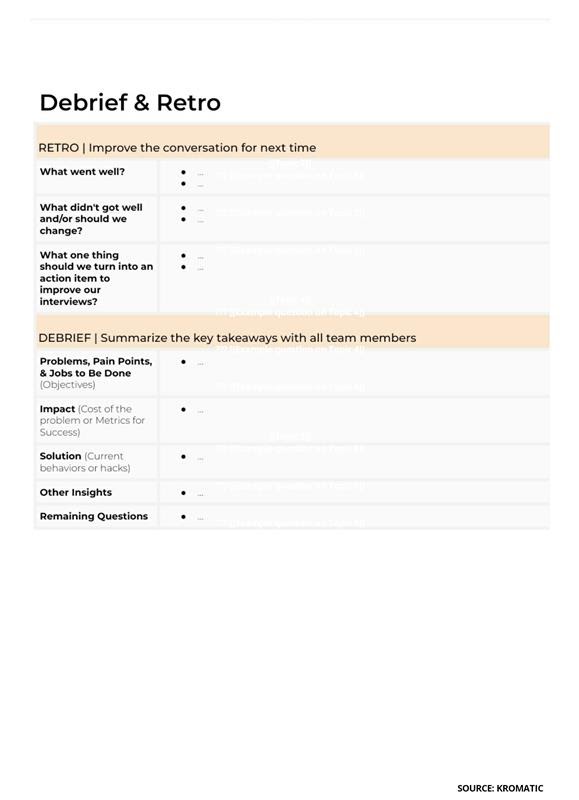
Customer Discovery Canvas

Use this canvas in the initial stages of conversation with your prospective customer to explore and record relevant Discovery topics.
This canvas can be used for a single-call close or can be used across multiple customer calls.
Just follow these simple steps that are shown in the image. If you want to create your own customer discovery process canvas you can also use the Mural app.
- You can create notes from your own pre-customer call Discovery or information shared by your SDR.
- The upper portion is dedicated to the company, industry trends, company news, and other interesting things that you learn about your customer and their business.
- The lower section is for stakeholders you research. It’s totally fine if your customer sees this work- it’s good!
- In this, you can record your conversation with your customer. And choose to do all the recording. If your customer is comfortable, you can invite them to collaborate with you in real-time.
- You might create a color key to designate people who will make the decision, people who should be consulted or informed, people who would influence the decision, and so on solution Requirements.
Wrapping Up
In the end, There are many reasons why entrepreneurs overlook customer discovery. But understanding how customers think is an element of creating successful products.
No matter how tough it is, you have to be the toughest.
To make the most of the customer discovery process, you need to know about your mistakes.
There is no point in moving forward with the process if you know that you are forcing your solution into a market that has no room for it.
So trust yourself. Kick that self-doubt out. There’s absolutely nothing to hold you back. Interview your customers.
Make the needed products.


